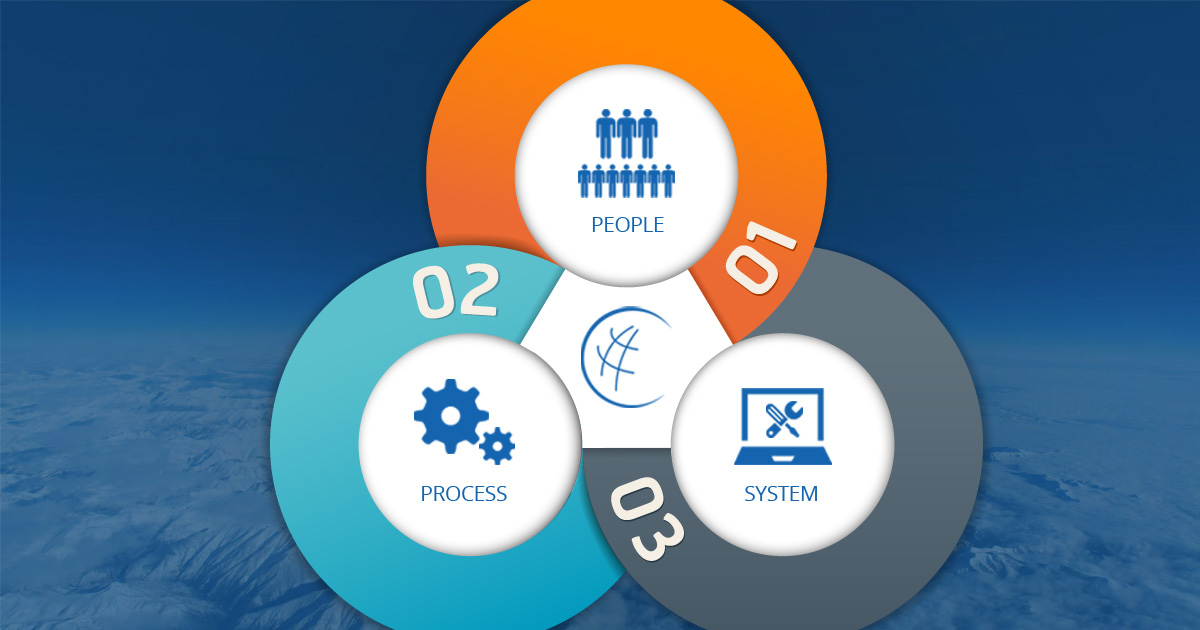At AllianceTek, we believe that technology alone does not necessarily provide any benefits to a business. Instead of just providing technology, our role as business solutions architects is to determine how technology can best be applied to a business.
As businesses attempt to leverage information technology to gain an advantage, they are basically trying to find a solution that saves time, and money, and improves the quality of tasks. However, the reason a new IT solution may not result in these expected benefits is that the technology does not align the people, processes, and systems that make up a task.
In this article, we will discuss how the alignment of people, processes, and systems is essential to empower workers and deliver benefits to a business.

The Three Parts of a Task
All tasks, whether simple or complex, consisting of three parts: a human part, a process with a series of steps, and a system that controls the frequency of the task. When these parts of a task become misaligned, the result is lost time, money, and poorer quality. For instance, if the task has no system to regulate the frequency, then it may not be performed on time. If a task has no process, then the person performing the task wastes time determining and re-determining how to do the task each time. And if a task has no human element, then the quality may suffer because there is no one there to follow through with it and recognize how to make it better.
Issues occur when one part of a task tries to do the part of another. Your workers should not have to be responsible for remembering how and when to do a repetitive task; these things should be handled by the process and system elements. Forcing workers to remember these things prevents them from contributing to an instance of the task and causes a business to stagnate rather than grow.
Why People, Processes, and Systems Become Misaligned
One reason why the people, processes, and systems become misaligned is that the task may not be clearly defined. Take a routine task performed as part of your business and try to determine a way it can be automated. If this does not come easy, it may mean you have not clearly defined the task. Only clearly defined tasks can be automated, and automating tasks forces you to define the task.
Another reason for misalignment is a lack of communication. If people within an organization are not communicating effectively, then the processes and systems that support the tasks will not be aligned with the people performing them.
Recognizing Patterns and Defining Tasks
Recognizing patterns in the way a business operates and defining tasks from these patterns is largely how IT solutions can successfully deliver benefits. Once a task has been defined and its people, processes, and systems aligned, the task can now be delegated, automated, or outsourced. This empowers the people handling these tasks because now they can focus on finding more efficient and less expensive methods of handling the task.
Aligning People, Processes, and Systems
To align people, processes, and systems, it's essential to involve all the stakeholders in the process. This includes management, workers, and IT specialists. A comprehensive analysis of the task should be conducted to understand how the people, processes, and systems interact with one another.
The analysis should answer the following questions
- Who performs the task?
- What are the steps involved in performing the task?
- How often is the task performed?
- What systems are in place to support the task?
- What are the quality requirements for the task?
Once the analysis is complete, the task should be defined clearly, and the people, processes, and systems aligned accordingly. This may involve automating certain steps of the task or implementing new systems to support the task. It's important to ensure that the people involved in performing the task have the necessary skills and training to use the new systems.
Automating Tasks
One of the most effective ways to align people, processes, and systems is through task automation. By automating tasks, workers can focus on tasks that require their expertise, creativity, and innovation. Automation ensures that tasks are performed consistently and accurately, reducing the risk of errors and improving the quality of output. Automation also saves time and reduces costs associated with manual tasks.
To automate a task, it's important to have a clear understanding of the task and how it's performed. The automation should be designed to complement the process and support the people performing the task. Automation should not replace people but rather empower them to do their jobs more efficiently and effectively.
Outsourcing Tasks
Outsourcing tasks is another way to align people, processes, and systems. Outsourcing allows businesses to tap into expertise that they may not have in-house. IT outsourcing also allows businesses to reduce costs associated with hiring developers and training staff for tasks that are not core to their business. Outsourcing can be particularly effective for tasks that require specialized skills or are performed infrequently.
However, outsourcing can also create new challenges if not managed effectively. It's important to choose a reliable and trustworthy outsourcing partner and to establish clear communication channels to ensure that the outsourced tasks are performed to the required standard. It's also important to ensure that the outsourcing partner understands the business and its objectives.
Empowering Workers
Empowering workers is essential to aligning people, processes, and systems. Empowered workers are more engaged, motivated, and productive. They are also more likely to contribute to process improvement and innovation.
To empower workers, it's important to provide them with the necessary tools and resources to perform their jobs effectively. This includes training, support, and access to information. It's also important to involve workers in the process of defining and improving tasks. Workers are often the best source of ideas for process improvement and innovation.
Conclusion
Aligning people, processes, and systems is essential to empowering workers and delivering benefits to a business. By recognizing patterns and defining tasks, businesses can ensure that the people, processes, and systems that make up a task are aligned. This can be achieved through automation, outsourcing, and empowering workers. A comprehensive analysis of tasks is essential to ensure that tasks are defined clearly and that the people, processes, and systems are aligned accordingly.
As business solutions architects, we at AllianceTek believe that technology alone does not provide any benefits to a business. It's the alignment of people, processes, and systems that delivers the benefits. Our role is to help businesses align their people, processes, and systems to deliver maximum value and empower their workers.
Call us at 484-892-5713 or Contact Us today to know more details about the Empowering Your Workers by Aligning Your People, Processes, and Systems


